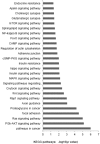MiR-199a-5p regulates sirtuin1 and PI3K in the rat hippocampus with intrauterine growth restriction
- PMID: 30217997
- PMCID: PMC6138635
- DOI: 10.1038/s41598-018-32189-5
MiR-199a-5p regulates sirtuin1 and PI3K in the rat hippocampus with intrauterine growth restriction
Abstract
In humans, malnutrition during pregnancy results in intrauterine growth restriction (IUGR) and an increased risk of neurological morbidities; altered miRNA characteristics have been suggested to contribute to IUGR neurological pathogenesis. A miRNA microarray was used to identify differentially expressed miRNA molecules in the hippocampi of rats with IUGR. Five of the molecules in question were selectively validated using real-time PCR in rats with IUGR. We then investigated the role of miR-199a-5p in hippocampal pathology. Bioinformatics analysis results suggested that TNF-α, caspase-3 and SIRT1 were potential targets of miR-199a-5p. Changes in PI3K, SIRT1 and caspase-3 protein expressions levels in the hippocampus were confirmed by Western blot analysis (all P < 0.05). Studies using the pheochromocytoma cell line PC12 cells and primary neurons demonstrated that miR-199a-5p modulated PI3K, caspase-3 and SIRT1 expression. Additionally, there was an inverse correlation between miR-199a-5p and caspase-3 expression, though dual-luciferase reporter assays showed that caspase-3 is not a target of miR-199a-5p. We conclude that IUGR affects hippocampal miRNAs characteristics. Our results also indicated that aberrantly high expression levels of miR-199a-5p may play an important role in the pathogenesis of IUGR by regulating SIRT1 and PI3K.
Conflict of interest statement
The authors declare no competing interests.
Figures





Similar articles
-
Targeting of microRNA-199a-5p protects against pilocarpine-induced status epilepticus and seizure damage via SIRT1-p53 cascade.Epilepsia. 2016 May;57(5):706-16. doi: 10.1111/epi.13348. Epub 2016 Mar 6. Epilepsia. 2016. PMID: 26945677
-
Implications for miR-339-5p regulation of trophoblast proliferation and migration in placentas associated with porcine intrauterine growth retardation using integrated transcriptome sequencing analysis.Theriogenology. 2024 Mar 1;216:127-136. doi: 10.1016/j.theriogenology.2023.12.035. Epub 2023 Dec 31. Theriogenology. 2024. PMID: 38181538
-
HSC-derived exosomal miR-199a-5p promotes HSC activation and hepatocyte EMT via targeting SIRT1 in hepatic fibrosis.Int Immunopharmacol. 2023 Nov;124(Pt B):111002. doi: 10.1016/j.intimp.2023.111002. Epub 2023 Oct 5. Int Immunopharmacol. 2023. PMID: 37804655
-
Bioinformatics prediction and experimental verification of a novel microRNA for myocardial fibrosis after myocardial infarction in rats.PeerJ. 2023 Feb 9;11:e14851. doi: 10.7717/peerj.14851. eCollection 2023. PeerJ. 2023. PMID: 36788811 Free PMC article.
-
Sulforaphane suppresses skin squamous cell carcinoma cells proliferation through miR-199a-5p/Sirt1/CD44ICD signaling pathway.Immunopharmacol Immunotoxicol. 2023 Feb;45(1):52-60. doi: 10.1080/08923973.2022.2112221. Epub 2022 Aug 22. Immunopharmacol Immunotoxicol. 2023. PMID: 35947042
Cited by
-
Advances in the role of silence information regulator family in pathological pregnancy.Zhejiang Da Xue Xue Bao Yi Xue Ban. 2021 Jun 25;50(3):335-344. doi: 10.3724/zdxbyxb-2021-0183. Zhejiang Da Xue Xue Bao Yi Xue Ban. 2021. PMID: 34402258 Free PMC article. Review. English.
-
Docosahexaenoic acid improves cognition and hippocampal pyroptosis in rats with intrauterine growth restriction.Heliyon. 2023 Jan 27;9(2):e12920. doi: 10.1016/j.heliyon.2023.e12920. eCollection 2023 Feb. Heliyon. 2023. PMID: 36747549 Free PMC article.
-
Regulation of HIF-1 by MicroRNAs in Various Cardiovascular Diseases.Curr Cardiol Rev. 2023;19(5):51-56. doi: 10.2174/1573403X19666230330105259. Curr Cardiol Rev. 2023. PMID: 37005512 Free PMC article.
-
[Effect of inhibiting miR-204 expression on the learning and memory abilities of neonatal rats with intrauterine growth restriction and related mechanism].Zhongguo Dang Dai Er Ke Za Zhi. 2022 Dec 15;24(12):1376-1383. doi: 10.7499/j.issn.1008-8830.2205140. Zhongguo Dang Dai Er Ke Za Zhi. 2022. PMID: 36544422 Free PMC article. Chinese.
-
Updates on the epigenetic roles of sirtuins.Curr Opin Chem Biol. 2019 Aug;51:18-29. doi: 10.1016/j.cbpa.2019.01.023. Epub 2019 Mar 12. Curr Opin Chem Biol. 2019. PMID: 30875552 Free PMC article. Review.
References
MeSH terms
Substances
LinkOut - more resources
Full Text Sources
Other Literature Sources
Research Materials

